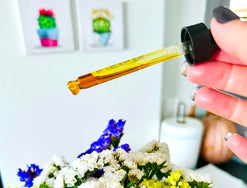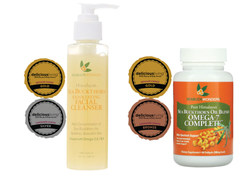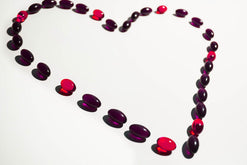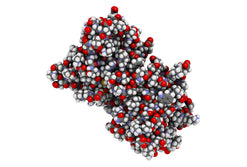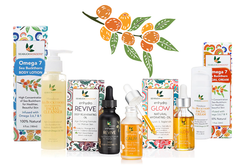Omega 7 Sources and Extraction Process
There are three main methods used today to extract oils from fruits and plants: CO2 supercritical extraction, Hexane solvent extraction, and cold press extraction. "Purification" is a newer extract method being used to extract Omega 7 from fish sources.
The way you extract oil really matters when it comes to the quality of the final product. Some extraction processes work better for certain types of plant materials. Sea buckthorn has its own set of challenges as a raw material and the truth is that not every extraction method will create a high-quality sea buckthorn oil product with great health benefits.
Types of Omega 7 Extraction Processes
Hexane Solvent Extraction
Solvent extraction is a method for processing materials using a solvent to separate the various components within the oil. It is most commonly used with liquids but can also be used for gases and solids. In this method, a solvent (typically Hexane) is introduced to the material and separates its components.
The separated components are removed individually to gather the oil. The oil is then cleansed with alcohol to remove the solvents and any other unwanted plant materials such as pigments and waxes released during the process.
The alcohol is then evaporated leaving only the extracted oil. Albeit a very common and economical extraction method, hexane solvent is not the cleanest and most environmentally friendly choice. It also uses high temperatures, which may diminish the nutrients.
- A fairly pure extract that is cheap and popular with many fruit extracts.
- Not as environmentally friendly as other methods. Hexane comes from gasoline, making it toxic and flammable.
- Temperature range is high and may damage the nutritional profile of the oil.
- High oxidation levels make the final product lower quality, with less nutritional content.
Cold Press Extraction
For many years cold pressing was the most common way to extract organic oils. It is a simple method where oil is made from pressing or grinding fruit or seeds with stainless steel presses. There is a little bit of heat produced in the process due to friction that averages at about 40 degrees Celsius.
For an oil to be marked as cold pressed the temperature cannot rise above 49 degrees Celsius. In general, cold press is preferable to Hexane solvent extraction because it’s much cleaner and more natural.
Cold Press isn’t best for Sea Buckthorn oil
However, it is not as efficient at extracting high oil content as Co2 Extraction. It does have lower temperatures and oxidation rates, which may better preserve the nutrient profile. Still, this method does not stand up to Co2 extraction- especially when it comes to sea buckthorn oil.
Cold press is not the best way to extract sea buckthorn. One major problem is that sea buckthorn seed oil cannot be made using cold press. We go more into why we don’t use this method here.
- Basic manual technology. Leads to lower purity levels.
- Clean and natural process. Uses no toxic chemicals.
- Environmentally friendly but low efficiency. Leads to high waste.
- Medium temperature from friction. May affect nutrient profile.
- Oxygen is present in the process and causes the oils to oxidize immediately
- High oxygen levels and medium temperature may diminish nutrient profile during extraction.
- Co2 extraction uses colder temperatures than cold press!
"Purification" Extraction
Today we're seeing Omega 7 being "purified" from fish oil sources. Contrary to the name, there is very little that's pure about this process. "Purification" uses a 7-step process where Crude fish oil is turned into a standardized 50% Omega 7/Palmitoleic Acid product.
The 7-step process being used goes like this: Crude fish oil – deacidification – bleaching – ethyl transesterification – molecular-distillation – fractional-distillation – recrystallization – and packing. The high heat created during these processes is known to break down nutrient quality in the final product. Purification is a newer industrial process and the information available is scarce.
SeabuckWonders Uses Supercritical CO2 Extraction
We only use supercritical CO2 extraction to create our products. Sea buckthorn has so much nutrition that we want to preserve. It just wouldn’t make sense to use another method.
We've noticed an influx of very inexpensive sea buckthorn oil products entering the market. The extraction method used to make those oils are questionable at best. Be sure to learn more about this important issue here.
How it Works
Super critical CO2 extraction is a state-of-the-art method that best preserves the active properties of a plant. The process is efficient and makes the purest plant extracts possible.
In this process, CO2 in its super critical state is passed through raw plant material. When CO2 is cooled to 30 degrees Celsius and pressurized, it changes from a gas to a super critical state, which is a state between liquid and gas.
The CO2 extracts all of the important nutrients as it passes through the plant material. There is no thermal stress and no solvents are used.
CO2 Supercritical extraction is the cleanest, most environmentally friendly and efficient method to extract sea buckthorn oil while best preserving the nutritional profile of the fruit.
- Protects and preserves nutrition better than other methods, makes the purest extracted oil.
- Natural – no toxic chemicals used in processing.
- Lowest temperature of any oil extraction method!
- Environmentally sound and efficient. Low heat, no harsh chemicals, and far less waste.
- No oxygen means no risk of oxidation.
- Very high preservation of nutrients that tends to preserve the genuine aroma of the plant.
Extraction Comparison
| CO2 Supercritical | Hexane Solvent | Cold Pressed | "Purification" | |
| Purity | High | Medium | Low | High |
| Natural | High | Low | High | Low |
| Efficiency | High | High | Low | Low |
| Environmentally Friendly | High | Low | Med | Low |
| Temperature | Low | High | Med | High |
| Oxidation | Low | High | Med | Unknown |
| Nutrient Preservation | High | Med | Low | Low |
Is Omega 7 from Sea Buckthorn Healthy?
Fish oil brands claim that purification is the only way to get healthy omega 7. This couldn’t be farther from the truth but this myth, perpetuated by marketing, persists to this day. Some brands claim that they must use purified fish oil because of the palmitic acid content found in other omega 7 sources- including sea buckthorn.
The first reason purified fish oil is not the top source for omega 7, is that purified oils become unstable in this process. Since the structure of the molecules is disturbed, and all other nutritional components are removed, purified fish oil spoils easily.
Lower Quality oils and Nutrients
Fish oil is not very shelf stable and tends to go rancid quickly. Ever taken a fish oil supplement in the morning only to have an unpleasant flavored burp later in the day? It’s not just because the oil is made from fish- it’s also because the oil is likely rancid, causing a pungent odor and flavor (gross, we know).
The second major flaw in the argument against sea buckthorn oil as a healthy source for omega 7 is the issue the companies have with palmitic acid itself. It’s true that sea buckthorn has palmitic acid, but so does olive oil, human breast milk, and nearly all dairy products. For an in-depth explanation of why palmitic acid is nothing to fear, be sure to stop by this article.
- Questionable- heavy industrial process
- High temperatures and heavy processing waste precious other nutrients
- Temperatures, chemical compounds, and synthesizing damages nutrient profile during extraction
The Best Quality Oils Come from Seabuckwonders
As you can see, supercritical C02 extraction is the best way to create sea buckthorn oil. We only use this process to create our oils and we are one of the only brands to have our own source for raw material. When it comes to omega 7, we know that the best source is sea buckthorn berries.
Our only concern is creating the best quality sea buckthorn oil products available in North America. It wouldn’t make sense for us to use another extraction method. Someday, if an even better method comes along, we will make the switch. For now, supercritical CO2 extraction is the best method for creating plant oils.


